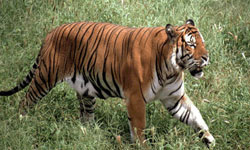
'' Dudhwa National Park is one of the best exemplars of the extremely varied and fruitful Terai eco-systems. The southern boundary of the park is marked by River Suheli and the northern edge of the sanctuary lies along the Indo-Nepal border.
Dudhwa National Park is a home to the Swamp Deer or the largest kind of Indian Deer with twelve magnificent antlers.
There are 101 tigers and 4 leopards in the Dudhwa Tiger Reserve. The national park has a few rhinoceros and birds like Bulbul, Painted Storks, Cranes and night birds like Bee Eaters, Great Indian Horned Owl, Kingfishers and Woodpeckers.
''
Dudwa National Park is a stronghold of the barasingha/ swamp deer, which can be spotted in herds of hundreds. India is the only country where this species of deer is found. It is interesting to note that around half of the total Barasinghas on the Earth are present in Dudhwa National Park. Smaller than the sambar, the barasinghas have 12 antlers that collectively measure up to 100 cm.
Dudhwa National Park lies amid the warm, tropical forests of the Terai, in the foothills of the Himalayas. It is the largest and thickest forest reserve of India. The park's thick Sal forest, extensive grasslands and marshes harbor a wide range of wildlife. It is a home for over 38 species of mammals, 16 species of reptiles and numerous birds.
The swampy land and marshes is a haven for numerous species of birds both local and migratory. There are spectacular painted storks, black and white necked storks, cranes and owls. Colourful woodpeckers, barbets, kingfishers, minivets, bee eaters, and bulbuls flit through the forest canopy painting the sky. A natural paradise, Dudhwa protects its wild habitat from the depredations of an expanding human population.
Attractions in Dudhwa
Frog Temple : From Dudhwa national Park, the tourists can make a fine excursion towards the unique Frog Temple at Oel town which is 12 kms from Lakhimpur on the route from Lakhimpur to Sitapur. This is one of its kind of temple based on the Maduk Tantra and was built by the former king of Oel state during 1860-1870. The temple is actually dedicated to Lord Shiva and is believed to be built on the back of a large frog. The Temple is constructed within an octagonal lotus. The Shivling installed in the temple was brought from the Banasur Prati Narmdeshwar Narmada Kund.
Surat Bhawan Palace : Built in 1894, the Surat Bhawan Palace near Dudhwa National Park is made in Indo-Sarasenic style and is composed of ten bedrooms, one large dining room with pantry and two lounges. The palace set in a large green, nine acre retreat is eight kms away from the park with its eastern entrance facing the reserve.
Best Time to Visit Dudhwa National Park
The best time to visit Dudhwa National Park is between November and May. The park remains open to public from November to June, though the months of May and June are a little too hot for comfort.
How to Reach there
Air: Lucknow is the nearest airport. Many airlines operate a number of flights to Lucknow from major cities across India. Outside India, Nepal at a distance of 35 kms is the nearest airport.
Rail: The nearest railheads are Dudhwa (4 kms), Palia (10 kms) and Mailani (37 kms), though the most convenient way would be to travel to Lucknow and then reach Dudhwa by road or train.
Road: Bus services link Palia to towns such as Lakhimpur Kheri, Shahjahanpur, Lucknow, Bareilly and Delhi. You can get regular buses between Palia and Dudhwa.